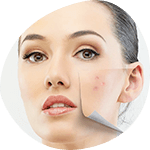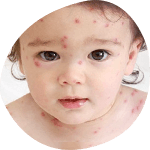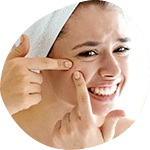Introduction
Acne is a very common skin disease. According to statistics, it affects up to 80% of the population aged 12 to 25 years, and about 30 - 40% of people over 25 years of age. The trend of "growing up" of this disease determines the relevance of this problem and the need to develop new effective means and treatment regimens. In more than one third of cases, this pathology requires serious, sometimes long-term treatment by a specialist.
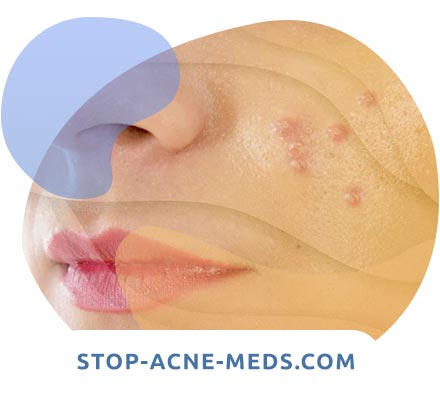
It begins in the third or fourth decade of life and reaches its peak between the 40th and 50th year. Women suffer more often (60%), although hyperplasia of the connective tissue and sebaceous glands, leading to rhinophyma, are observed exclusively in men. Rosacea is found in all races, but mainly in fair-skinned and very rarely in blacks (blacks in Africa and America). Epidemiological studies in North America show that rosacea affects between 5% and 7% of the population. In the Scandinavian countries this figure reaches 10%, while in Germany it is estimated at 7%. The English call rosacea "the tides of the Celts." People of Irish descent are more likely to have more pronounced forms of the disease.
Etiology
Many processes that occur in the skin are regulated, including the secretion of the sebaceous glands and the rate of keratinization (keratosis). They are produced in the adrenal glands, as well as in the male and female sex glands - the testes and ovaries. During puberty or due to pathological changes, increased production of androgens is observed, leading to hypersecretion of sebum and excessive keratinization of the epidermis.
External factors affecting the development of acne include non-compliance with personal hygiene rules, improperly selected cosmetics, adverse climatic conditions, excessive ultraviolet radiation, and harmful working conditions. Internal mechanisms are represented by emotional stress, malnutrition, diseases of the internal organs. Improper nutrition implies the predominance of saturated fats, refined carbohydrates in the diet, as well as the abuse of spicy, spicy and salty foods. The hereditary predisposition is based on the different activity of the genes responsible for the development of the sebaceous glands, the intensity of their work, the synthesis of hormones that regulate their activity. This can explain the presence of mild and severe forms of the disease, as well as the high likelihood of developing acne precisely in patients whose relatives faced a similar problem. As a result of the action of all these factors, an increased secretion of sebum with a changed qualitative composition develops. It practically loses its bactericidal properties, as a result of which active reproduction of pathogenic microflora begins on the surface of the skin.
The penetration of liquid sebum into the epidermis reduces its protective properties, disrupts the process of natural exfoliation. In parallel, intense keratinization of cells lining the cavity of the follicular canal occurs, as a result of which the pores become clogged and comedones form. The accumulation of harmful bacteria and fungi on this substrate causes inflammation and the formation of acne. Violation of the process of normal keratinization occurs due to a lack of secretion of the sebaceous glands of linoleic acid. This contributes to the increased content of cholesterol compounds.
flakes accumulate at the surface of the skin. In the case of a deep bed, the drainage of the duct, oxygen access completely ceases, and favorable conditions are created for the propagation of pathogenic microflora, especially bacteria Propionibacterium acnes. It is such closed comedones that most often degenerate into inflammatory elements of acne.
path, endocrine system dysfunctions, psychosomatic and immune disorders, as well as a number of endocrine factors. A genetic predisposition to rosacea has not been established.
A number of elementary factors (alcohol, hot drinks and spices) stimulate the gastric mucosa and, due to reflex action, cause expansion of the blood vessels of the face. It is believed that excessive consumption of meat in the food is the reason for the formation of rhinophyma. However, rosacea also develops in vegetarians, which casts doubt on this assumption. There is no reliable relationship between the reaction of hot flashes and the ingestion of foods with a high content of sodium glutamate, used as flavoring additives in meat products (syndrome of Chinese restaurants). The abuse of coffee, tea or cola, according to some scientists, is pathogenetically associated with rosacea, however, careful studies have shown that water with a temperature above 60 ° C causes blood flow to the skin of the face, and not coffee itself [J. K. Wilkin, 1979]. Nevertheless, the authors nevertheless prescribe in the dietary recommendations for patients with rosacea to exclude erythema-causing foods such as alcohol, hot drinks, spicy foods, and citrus fruits.
One of the factors determining the development of rosacea is an increased content of porphyrins in the secretion of the sebaceous glands of the skin, which, in combination with a number of other reasons, causes photodynamic damage to the structural elements of the skin.
The presence of pustular elements, as well as the effectiveness of the use of antibacterial drugs for rosacea, suggested the infectious nature of the disease. However, with repeated bacteriological studies, the etiological role of bacteria has not been proven - the contents of pustules in most cases are sterile. Gram-negative microorganisms only indicate the severity of the disease (gram-negative rosacea).
One of the most common causes of rosacea is the presence of ticks of the genus Demodex folllculorum. The histological examination of ticks in individual infiltrates, as well as the effectiveness of acaricidal drugs (hexachlorocyclehexane, crotamiton, benzyl benzoate), metronidazole and sulfur in rosacea confirm this assumption. At the same time, the localization of the eruptive elements of rosacea is mainly not associated with the follicular apparatus, and Demodex folllculorum is not found in all patients. Demodex folllculorum is a physiological representative of the microflora of the skin, its population of follicles increases significantly with age. External use of sulfur in rosacea leads to clinical improvement, but not to histopathological reduction of tick larvae. Most authors attribute the occurrence of the extrafacial form of rosacea to infection with Demodex folllculorum. Some patients even show specific antibodies to demodex.
According to some scientists, a violation of the gastrointestinal tract does not play a leading role in the pathogenesis of rosacea. In 50-90% of patients with rosacea, clinical and histological signs of gastritis were revealed, and in 33% - pathological changes in the mucous membrane of the jejunum. Based on the results of a study of gastric juice, pathogenetic significance is often given to a hypo- or anacid state, less often to a hyperacid state. An association of rosacea with chronic inflammatory diseases of the stomach and intestines has been reported.
Some researchers regard the presence of diabetes mellitus and a 15% decrease in lipase secretion as evidence of the pathogenetic significance of metabolic disorders in patients with rosacea. Ovarian and pituitary insufficiency, thyroid diseases and other hormonal disorders are not considered as single causes of rosacea, since men and women of different age groups suffer from this disease. The influence of adrenal insufficiency on the formation of rosacea based on the positive effect of the administration of adrenal hormones was noted.
Classification
The generally accepted classification of acne has not yet been developed. Existing acne classifications are based on the clinical presentation of the disease or on the assessment of its severity. One of the most comprehensive is the classification proposed by Plewig G. & Kligman A. M. [1994].
- Acne neonates (acne neonatorum)
- Acne Conglobate Babies
- Acne Comedone
- Acne papulopustular
- Acne Conglobate
- Acne Inverse
- Acne fulminant
- Solid persistent edema of the face with acne
- Mechanical acne
- Acne adults (acne adultorum)
- Acne back area
- Acne Tropical
- Late Acne in Women
- Premenstrual Acne
- Hyperandrogenic acne in women
- Acne for Adroluteoma Pregnant
- Androgenic acne in men
- Conglobate acne in men with XYY chromosome set
- Testosterone-induced fulminant acne in tall adolescents
- Contactless (contact acne, acne venenata)
- Acne Cosmetic
- Acne provoked by lipstick for hair
- Acne provoked by oils, tar, resins
- Acne comedone due to physical factors
- Solar Comedones (Favre-Rakusho Disease)
- Mallorca acne (acne aestivalis)
- Acne due to ionizing radiation: X-rays
However, in recent years, new data have appeared in the interpretation of some issues of acne, therefore, this classification should be supplemented and modified. The most successful, in our opinion, is the etiopathogenetic classification proposed by K. N. Suvorova, N. V. Kotova [1997] with additions.
Seborrheic acne in childhood, adolescence and adolescence:
- Acne of the newborn (acne neonatorum);
- youthful acne (acne juvenilis).
Late acne:
- premenstrual acne
- postmenopausal acne;
- late hyperandrogenic acne (Stein-Levent syndrome and other hyperandrogenism in women);
- conglobate-cystic acne in men with Chromosome Polysomy Syndrome (XYY) and Klinefelter Syndrome.
B. Provoked acne
- Cosmetic (acne toxica, acne venenata, acne de la bril-liantine).
- Excreted acne (acne excoriee des jeunes filles, acne neurotica).
- "Pyoderma of the face."
- Resistant Acne
Classification of rosacea by severity.
- Rosacea II. Papules, papulopustules and pustules.
- Rosacea III. Inflammatory nodes and plaques.
Articles
Clinic
Acne of newborns (acne neonatorum) appears in newborns under the influence of maternal hormones (estrogenic acne of newborns), due to the excessive function of the sebaceous glands and have the appearance of dotted papules of pearly white color with a yellowish tint. Localization of rashes - the area of the forehead, cheeks, on the tip and wings of the nose, in the nasolabial folds, sometimes on the penis. Acne in newborns can be in the form of closed comedones, papulopustules and, less commonly, nodes. Elements are grouped, pass within a few days or after 2 weeks. Acne in newborns resolves spontaneously and therefore rarely requires treatment.
control of testosterone levels with temporary gonadal activation. Infant acne usually occurs in boys later than 3 months of life and can last up to 3-4 years. They are manifested by grouped papules and inflammatory acne, which can often result in cicatricial atrophy of the cheek skin.
Youthful acne (acne juvenilis) - a disease with typical foci of acne at an age not typical for acne. They differ from acne that occurs in adults due to hormonal, nervous and other disorders (premenstrual, excoriated acne, medical acne). Rashes in adolescence are mainly papules and pustules, and, very rarely, if the disease lasts a long time, there are comedones. Youthful acne is very common at the age of 12-16: one third of teenagers suffer from acne, and according to some authors [P. Popkhristov, 1963; R. E. Pochi, 1990] acne is observed to one degree or another in 90% of adolescents.
Idiopathic (late) acne is considered age dependent and persists after puberty or appears in adults. They can be a manifestation of a number of serious diseases accompanied by hyperandrogenism: Stein-Leventhal syndrome, a late type of congenital adrenal cortical hyperplasia syndrome in women, XYY syndrome in men. Klinefelter's syndrome (polysomy on the X chromosome in men) is accompanied by cohlobate acne. With Cushing's syndrome, adrenal tumors, acne-like rashes can appear at any age.
Late types of acne include premenstrual and postmenopausal acne. Premenstrual acne is observed in girls and women in the form of acne-like rashes on the chin and cheeks in the period before menstruation.
hirsutism, ovarian enlargement. Acne is also a common symptom. When studying hormonal status, there is an increase in the content of LH in the blood with a normal or reduced level of FSH (the ratio of LH / FSH is more than 3), an increase in the level of testosterone and androstenedione, and a decrease in the level of blood estrogen. According to the tests of functional diagnostics, anovulation is detected. The pathognomonic signs of Stein-Leventhal syndrome, according to ultrasound, are an increase in the size of the ovaries and the presence of multiple follicular cysts.
With adrenogenital syndrome, a recessively inherited enzyme defect in the biosynthesis of cortisol in the adrenal cortex is observed. Too low cortisol production in the adrenal cortex causes an increase in the production of ACTH in the pituitary gland and, thereby, an increased synthesis of 17-a-hydroxyprogesterones. They cannot be enzymatically converted to cortisol. Classical forms of adrenogenital syndrome manifest themselves already in childhood and do not play any role in the sense of acne and hormones. Partial enzyme defects or functional impairment may, however, occur in the transitional or adult periods and, in some cases, are associated with late manifestations of acne in women.
Hyperandrogenism of the adrenal genesis (a late form of adrenogenital syndrome), manifested in the postnatal period, is characterized by the early appearance of viril symptoms. Hirsutism appears before or immediately after menarche. The first menstruation may be delayed, in the future menstruation is rare or absent. Almost all patients experience acne vulgaris on their back, chest, and face. Some patients may have dark skin or extensive hyperpigmented spots. Hypoplasia of the mammary glands is observed. The excretion of androgens in the urine exceeds the norm by 1.5-2 times.
Other endocrinopathies with androgenizing symptoms - hyperprolactinemia, as well as hyperandrogenism with insulin resistance and acanthosis nigrikans (black acanthosis) can also be accompanied by an acne-like rash, but dermatologists with this pathology are rare.
Polysomy syndrome of the Y chromosome in men (XYY syndrome) is manifested by severe nodular cystic acne, high stature, cryptorchidism, and a small penis. Patients are characterized by aggressive antisocial behavior; tendency to sexual perversions, vagrancy; decreased intelligence.
Polysomy on the X chromosome in men (Klinefelter syndrome, XXY syndrome) is characterized by severe cystic acne, varicose veins and leg ulcers. Klinefelter's syndrome is caused by an abnormality of the sex chromosomes, a characteristic symptom of which is a violation of spermatogenesis. Patients most often have one extra X chromosome, less often several chromosomes (karyotype 47 XXY; 48 XXXY; 49 XXXXY). The disease manifests itself in puberty. In the classical form of Klinefelter’s syndrome, patients are tall, eunuchoid body proportions: disproportionately elongated compared to the trunk of the limbs, female fat deposition, a wide pelvis, narrow shoulders, true gynecomastia is characteristic. Patients suffer from impotence, infertility, hypogonadism, hypoplasia of the testes and penis. It was found that mental retardation increases with an increase in the number of X chromosomes. Patients are prone to homosexuality, alcoholism, antisocial behavior.
growth retardation during puberty with premature puberty, acne vulgaris, hypertension, metabolic disorders.
development. With glucoandrosterome, virilization phenomena develop. With Itsenko-Cushing's syndrome, persistent hypertension, hypercholesterolemia, overweight, severe osteoporosis are observed. Neurotrophic changes in the skin, as well as acne vulgaris, are noted. Pathological hair growth is not always found. If hirsutism is not characteristic with glucosterome, then with glucoandrosterome the earliest symptoms of the disease are pubic, trunk, limb hairiness, clitoris virilization, menstrual dysfunction like amenorrhea.
Acne artificialis (acne artificialis) - mechanical acne that occurs in people with a predisposition to the disease and their appearance is due to pressure and friction, causing mechanical obstruction of the follicle holes.
As an example of mechanical eels, there may be a long squeezing of a close headgear, a sports helmet, a plaster cast. Mechanical acne can be triggered in various areas of the skin by the following factors: face (the habit of putting your face on your hands; rubbing your face with your hands or fingers; using band-aid on your chin; wearing hockey, motorcycle or football helmets; wearing bandages on your forehead; hats); neck (collars, shirts, sweaters, backpacks, band-aid, violin); shoulders (football and hockey shoulders; straps from backpacks; surgical dressings; orthopedic corset); arms and legs (surgical dressings, orthopedic corset); back (back of chairs; seat of a bus, car, boat; orthopedic braces and corsets; bras; bed rest; wide belts; backpacks and shoulder straps); chest (wrestling; football pads; orthopedic corsets); buttocks (chairs and seats). Various prolonged pressure and friction can lead to increased acne.
For example, the term "chin acne" states the effect due to the prolonged support of the chin on the hands. The effects of various injuries on acne patients show how various types of mechanical forces can exacerbate existing acne. Such forces include pressure, friction, tension, rubbing, tingling and the rest of the spectrum of mechanical stresses. The likelihood of new foci during injury is proportional to the severity of acne. Mild acne is usually indifferent to the effects of such forces, but with severe inflammatory acne, even moderate trauma can provoke papulopustules, and sometimes nodes.
However, mechanical forces do not cause comedones. Most severely mechanical acne occurs with a. fulminans in young men who have to wear orthopedic corsets. Some forms of mechanical acne are called the violinist’s neck. Since the role of emotions in acne is recognized, the mechanical acne itself is sometimes explained by the work of the hands, and not by the secrets of the psyche.
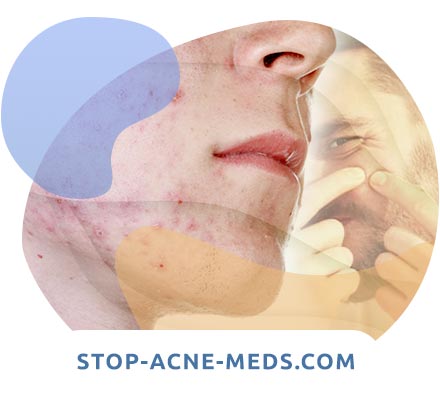
Acne patients are most prone to foci due to mechanical or physical factors. These foci can occur in unusual places, for example, on the buttocks, if patients sit for a long time in one place or at the waist, if they wear tight wide straps. Mechanical factors are well seen in tropical acne in a hot, humid climate. In wartime, acne is most difficult when wearing duffel bags, backpacks, and straps that are tightly tightened with straps and traumatize the skin. Preventive measures should be taken against mechanical acne, since inflammatory foci often leave scars.
Heavy oils in contact with skin can cause oil acne in auto mechanics, which can be outside typical acne areas. It occurs mainly in men (more often in brunettes with thick hair). In pathogenesis, mechanical (oil blockage of the excretory ducts of the sebaceous glands) and chemical (irritating effects of oils in combination with changes in the properties of sebum) factors are of great importance. Rashes are located mainly on the extensor surfaces of the forearms, abdomen, hips, legs. The clinical picture is characterized by numerous follicular comedones and inflammatory acne that develops in case of secondary staphylococcal infection. Dermatosis is characterized by a sluggish course and the absence of subjective sensations (in the absence of a secondary infection). Termination of contact with occupational hazards and compliance with hygiene measures leads to a fairly rapid regression of rashes.
Cosmetic acne (acne cosmetica) is a variant of contact acne. Skin lesions are found almost exclusively in women, mostly 20-30 years old, who abuse cosmetics. The use of cosmetics can cause such adverse reactions as the appearance of comedones and folliculitis, which suggests that active cosmetics can cause acne, aggravate or prolong their course. The localization of lesions on the skin corresponds to the field of main use of cosmetics: chin, cheeks and forehead. Clinically, mainly closed comedones are observed, less often - papulopustules and papulovesicles resembling pseudofolliculitis. Open comedones, by contrast, are very rare.
Excoriated acne (acne excoriee des jeunes filles, acne neurotica) is a special form of the disease that refers to the late type of acne. If earlier this disease only affected women, today it can also be found in young men seeking a career. In most cases, this acne is expressed in a weak form, but each new rash is immediately attacked in front of the mirror, squeezed out, scratched, or processed by any tool. The face is usually affected. Excorations can be against the background of already existing acne and without them. Acne excoriee smoothly turns into a disease with abnormal neurotic behavior. Often there are reactive depression, so patients are advised to consult a psychotherapist or neuropsychiatrist.
Clinical options for rosacea:
- ophthalmorosecea with blepharitis, conjunctivitis, iritis, iridocyclitis, hypopioniritis, keratitis;
- steroid rosacea;
- conglobate rosacea;
- halogenated rosacea.
Fima with rosacea: rhinophyma, gnatofima, metofima, otofima, blefarofima
German and American dermatologists currently distinguish three consecutive stages during rosacea: erythematous-telangiectatic, papulopustular, pustular-nodular.
The onset of rosacea is characterized by livid tidal erythema, which can be caused by numerous non-specific stimulating factors: mechanical skin irritation, insolation, temperature fluctuations; the use of hot drinks, spicy foods, alcohol. At first, the duration of erythema ranges from several minutes to several hours, is accompanied by a sensation of heat or warmth, and then disappears without a trace, but soon appears again under the influence of provoking factors. Localization is often limited to the nasolabial region. In this state of change of relapses and remissions, the process can continue for many months and years. Subsequently, moderate infiltration, telangiectasia appears at the site of hyperemia. Erythema becomes more saturated, with a bluish tinge, often passes to the parts of the cheeks surrounding the nose, to the forehead and chin. During histological examination at this stage, only dilated blood and lymph vessels predominate.
Later, against the background of diffuse thickening of the affected skin, isolated or grouped inflammatory pink-red papules appear, often covered with delicate scales. Papules are capable of persistence for many days or weeks. The largest elements are infiltrated at the base. Further, most nodules undergo suppuration, forming papulopustules and pustules with sterile contents. Pustulization is formed due to cell-mediated immunity with diffusion of a large number of neutrophilic granulocytes in response to the presence of Demodex folliculorum. The lesion spreads from the centrofacial region to the skin of the forehead, behind the ear, the front of the neck, and even the presternal region. Histologically revealed perivascular lymphohistiocytic infiltrates in the epidermis mainly in the area of the follicles of the sebaceous glands. In the presence of pustules in the histological picture, spongiosis of the follicular funnel, atrophic changes in the follicular apparatus, as well as collagen destruction are observed.
In the future, due to a chronic progressive course, the pathological process leads to the formation of inflammatory nodes, infiltrates and tumor growths due to progressive hyperplasia of the connective tissue and sebaceous glands and persistent vasodilation. These changes affect primarily the nose and cheeks, less often the chin, forehead and auricles, creating a pronounced disfiguring appearance. Some authors consider this stage of the disease as an independent form - rhinophyma. Rinophyma is found almost exclusively in men. The shape of the nose becomes asymmetric, against the background of congestive-cyanotic erythema, numerous large telangiectasias are located. The functional activity of the sebaceous glands is sharply increased. When pressed from the mouth of the follicles, a whitish, pasty secret is released. Similar changes are also found in places of different localization: thickening of the skin on the chin - gnathophyma, pincushion-like thickening in the area of the suprapera and forehead - metaphym, growths on the earlobes - otofima, and also thickening of the eyelids due to hyperplasia of the sebaceous glands - blepharophyma. Rinophyma is considered as the most severe form of rosacea, which does not develop in all patients. This is confirmed by detailed pathomorphological studies.
With rosacea, in some patients due to constant connective tissue hyperplasia, sebaceous gland hyperplasia and vascular ectasia, a pineal, bumpy nose appears. Moreover, in addition to the pineal nose, there are also changes typical for rosacea. However, the pineal nose can also form without rosacea symptoms.
very pronounced and the shape of the nose becomes asymmetric. Sometimes there are multiple vermiform thickenings. The secretion of the sebaceous glands is sharply increased (seborrhea of the nose). When pressed from the deeply drawn in mouths of the sebaceous glands, a white paste-like secretion of follicular filaments is released, which consists of horn cells, fat, bacteria and ticks of the genus Demodex. Facial skin color from pronounced yellow to stagnant red. The basis of this process is mainly diffuse hyperplasia of the connective tissue, vasodilation, hyperplasia of the follicle of the sebaceous glands. This hyperplasia does not spontaneously disappear and cannot be treated with antibiotics.
Ophthalmorosacea (ocular rosacea). In every third patient, rosacea occurs with eye damage in the form of blepharitis, conjunctivitis, iritis, iridocyclitis, hypopionyrite or keratitis. Complications of eye diseases are not associated with the severity of rosacea and can be several years ahead of skin lesions. Typical of ophthalmorosis is cyclically flowing dry kerato-conjunctivitis, which is characterized by the sensation of foreign particles in the eyes and photophobia. Unsuccessful for the prognosis is rosaceakeratitis, which in extreme cases can lead to loss of vision due to clouding of the cornea. In case of eye damage in patients with rosacea, an ophthalmologist consultation is recommended.
Persistent edema. In rare cases, rosacea occurs under the picture of a persistent, indistinct, slight swelling of the face, which manifests itself on the forehead, in the area of the overhead or cheeks.
Special clinical forms of rosacea
Steroid-provoked (steroidal) rosacea develops in patients who have been using corticosteroid ointments for a long time, especially fluorinated, for a particular dermatosis. The result is the phenomenon of "steroid skin" with mild subatrophy and extensive dark red erythema, on the surface of which there are telangiectasias and papulopustular elements. After the abolition of local corticosteroids, as a rule, a temporary exacerbation is noted.
With a diascopy of which yellow-brown spots are sometimes detected. Adhering to each other, the papules form an uneven, tuberous surface. A similar clinical picture is identical to Lupus miliaris disseminatus faciei (Lewandowski-like tuberculide). According to the polymerase chain reaction in patients with lupoid rosacea, mycobacterium tuberculosis was not found in granulomas. Debatable remains the question of the identity or difference of lupoid rosacea and rosacea-like tuberculide Lewandowski.
Conglobate rosacea (rosacea conglobata) develops on the site of an existing rosacea and is characterized by the formation of large spherical abscessed nodes and induced fistulas. Such aggravation often occurs after taking drugs that include halogens (iodine, bromine).
Lightning rosacea (rosacea fulminans) is observed almost exclusively in young women and is the most severe variant of conglobate rosacea. In foreign literature, this form is described as Pyoderma faciale. The disease begins acutely, rashes are localized exclusively in the face, there are no signs of seborrhea. The causes of the fulminant form of rosacea are unknown. It is assumed the influence of psychomotional factors, hormonal disorders, pregnancy. Lightning-fast rosacea begins suddenly. The general condition suffers slightly. However, nervous and mental reactions in the form of depression and dysphoria, which are caused by the suddenness and severity of the disease, can be observed.
Predominant localization of rashes - forehead, cheeks, chin. Pronounced edema and erythema of bluish-red color, papules and pustules, nodes of hemispherical and spherical forms are formed. Inflammatory nodes quickly merge into powerful conglomerates, fluctuation appears, sinuses and fistulas form. On palpation, hyperthermia is noted. Lightning rosacea may be accompanied by blistering [N. N. Potekaev, 1999].
Massive accumulations of neutrophils and eosinophils are histologically observed. Then nonspecific reactions are formed, characterized by the presence of lymphohistiocytic infiltrates, epithelial granulomas with single cells of foreign bodies, destroyed collagen fibers. In bacteriological studies of the contents of pustules and fluctuating nodes, Staphylococcusepldermidis is usually detected.
The gram-negative form of rosacea is characterized by the formation of numerous folliculitis. When examining the contents of pustules, gram-negative bacteria are detected. Gram-negative folliculitis is a complication of prolonged, irrational therapy of rosacea with antibiotics, mainly of the tetracycline series. There are two types of gram-negative forms of rosacea. The most common type is 1, which is caused by various bacteria Enterobacteriaceae, as well as Pseudomonas aeruginosa, and is clinically manifested by small pustular elements. In type 2 caused by Proteusmirabilis, edematous papules and nodes are observed.
Dermatologist Degos R. first described a patient with chronic persistent edema and erythema of the upper half of the face of unknown etiology. Since the first patient was observed in the southern region of France, Morbigan, the disease was called Morbigan disease. The disease manifests itself centrofacially with damage to the middle third of the face. In this disease, against the background of morphological elements typical of rosacea, a strong, not preserving fossa with pressure is observed, swelling on the forehead, chin, eyelids, nose and cheeks. This is not about edema itself, but about an increase in connective tissue and the accompanying fibrosis that occur against the background of chronic inflammation and lymphostasis. Typical is a dark red color with a violet hue, pronounced edema with a transition to induction. The course is initially chronic recurrent, and then persistent. Subjective symptoms of the disease were not noted, however, the coarsening of the facial contours is cosmetically noticeable.
Histopathologically there is fibrosis, edema with the expansion of the lymphatic vessels, as well as perivascular and perifollicular histiocytic infiltrate. Characteristically increased mast cell count. Chronic inflammatory reactions with obstruction of the lymphatic vessels, disturbances in microcirculation and mast cell-induced fibrosis are possibly of pathogenetic significance. The chronic course, the absence of laboratory changes and the relatively specific histopathological changes, as well as resistance to therapy, are, in addition to the clinical picture, important criteria for establishing a diagnosis. The picture of the disease is described under another name: solid persistent edema of the face. Similar facial changes are found in acne, rosacea and Merkelsson-Rosenthal syndrome, but a possible causal relationship with them has not been established.
Treatment
Elements (for comparison: traditional treatment, including retinoids, gives a positive result only after six months or a year).
Special complex procedures aimed at normalizing the activity of the sebaceous glands and skin pH, including to reduce vascular permeability.
Procedures aimed at changing the structure of the skin, smoothing the skin texture and removing traces of blackheads - elements of post-acne. In this case, a mechanical rotational circular dermabrasion is used (I. Glubokova method) - without pain, swelling, with a short rehab period, which allows to significantly increase the cosmetic effect.
The complexes of procedures include hardware physiotherapeutic methods of treatment: ultratonotherapy, e, arsanvalization, galvanotherapy, phonophoresis, iontophoresis, microcurrent therapy, cryotherapy, oxygen therapy, cryotherapy, phototherapy, disincrustation; mesotherapy; ozone therapy, etc. In parallel, antibiotic therapy, treatment of dysbiosis and concomitant diseases, vitamin therapy, elimination of micronutrient deficiencies, retinoid therapy. Of great importance in the treatment of acne is given to home care and treatment. They are selected individually.
Methods, tools and procedures are selected and performed by the doctor individually. Treatment is highly effective, affordable, can be limited by any stage (according to the capabilities and wishes of the patient) and is not limited by the time of year.
The treatment of rosacea is complex
- Diet with the exception of alcohol, hot drinks, spices.
- Washing with cold infusions of herbs (chamomile, sage).
- Tetracyclines in generally accepted doses, erythromycin, minocycline.
- The course appointment of metronidazole.
- Isotretinoin (Roaccutane) is highly effective, especially in severe forms of rosacea.
Local treatment:
With the erythematous stage of rosacea, it is prescribed:
- indifferent creams in olive oil,
- pastes containing 2-5% tar, ichthyol, ichthyol and sulfuric talkers.
- Creams and gels containing metronidazole.
- Cryomassage courses for 10-12 sessions per course,
- electrocoagulation of telangiectasias.
Treatment of rhinophyma:
- surgical
Conclusion
Rosacea is often called “rosacea,” although acne and rosacea are completely different diseases. Acne is characterized by oily skin, beginning at a young age. Rosacea is observed, as already mentioned, after 30 years and is not always accompanied by seborrhea, that is, increased secretion of sebum. But at a certain stage, these diseases are similar and only a dermatologist can distinguish them.
With rosacea, a concomitant pathology of other organs can be detected: gastritis with low acidity, colitis, hormonal disorders, immune disorders, neurasthenia and depression. Rosacea is also called the "disease of educators", people whose work is associated with constant emotional stress.
In the mechanism of acne development, the main role is played by seborrhea, which reduces the bactericidal effect of sebum and leads to activation of coccal flora. An important role in the mechanism of acne is given to the bacteria Propionibacterium acnes and its metabolic products.
 DE
DE FR
FR IT
IT ES
ES